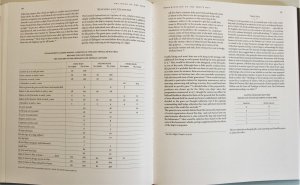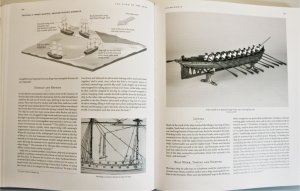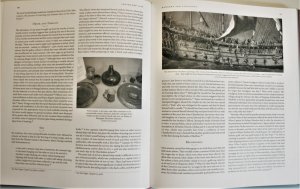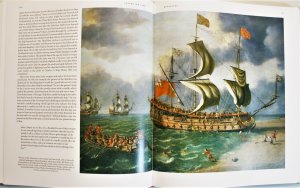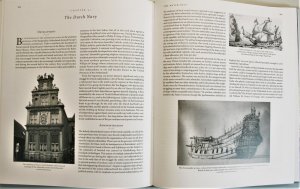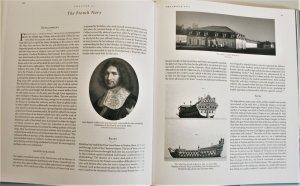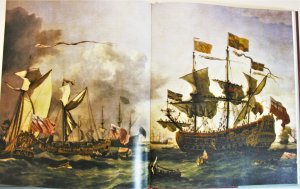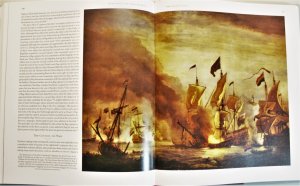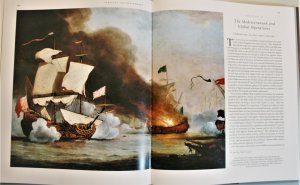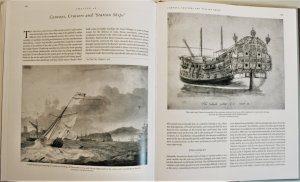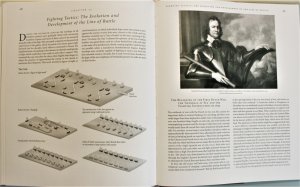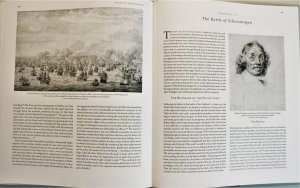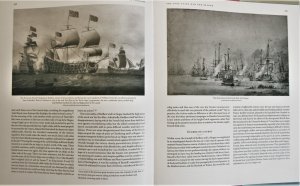Book Review
Pepys's Navy: Ships, Men and Warfare 1649-89
by J.D. Davies
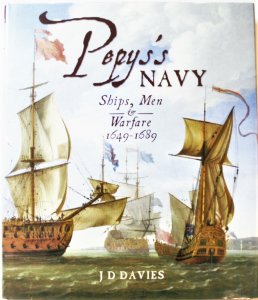
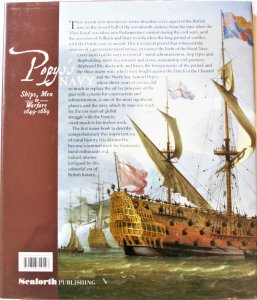
avialable as
Hardcover: 320 pages
Publisher: Seaforth Publishing; 1st Edition edition (20 Nov. 2008),
Language: English
Product Dimensions: 25.4 x 2.5 x 29.8 cm
or

Paperback: 320 pages
Publisher: Seaforth Publishing (30 July 2016)
Product Dimensions: 26.3 x 2.4 x 22.6 cm
Synopsis:
This new reference book describes every aspect the English navy in the second half of the seventeenth century, from the time when the Fleet Royal was taken into Parliamentary control after the defeat of Charles I, until the accession of William and Mary in 1689 when the long period of war with the Dutch came to an end. This is a crucial era which witnessed the creation of a permanent naval service, in essence the birth of the Royal Navy.Every aspect of the navy is covered - naval administration, ship types and shipbuilding, naval recruitment and crews, seamanship and gunnery, shipboard life, dockyards and bases, the foreign navies of the period, and the three major wars which were fought against the Dutch in the Channel and the North Sea. Samuel Pepys, whose thirty years of service did so much to replace the ad hoc processes of the past with systems for construction and administration, is one of the most significant players, and the navy which was, by 1690, ready for the 100 years of global struggle with the French owed much to his tireless work.This book is destined to become a major work for historians, naval enthusiasts and, indeed, anyone with an interest in this colourful era of the seventeenth century. JD Davies's authoritative study of the fledgling Royal Navy - PEPYS'S NAVY: Ships, Men and Warfare 1649-1689 - has won the fourth Samuel Pepys Award. In PEPYS'S NAVY, David Davies examines every aspect of the English navy in the second half of the seventeenth century, from the time when the Fleet was taken into Parliamentary control after the defeat of Charles I, until the accession of William and Mary in 1689 when the long period of struggle with the Dutch came to an end. This crucial era witnessed the creation of a permanent naval service, in essence the birth of the Royal Navy.Samuel Pepys played a pivotal role in the creation of a professional navy, first as a member of the Navy Board and later as Secretary to the Admiralty. His thirty years' service did much to replace the ad hoc processes of the past with systems for construction and administration. That, by 1690, the navy was ready for a century of struggle against the French owed much to Pepys's tireless work.The judges, who included the inaugural winner of the Award, Claire Tomalin, were unanimous in their decision to award the prize to David Davies.Speaking on behalf of the judges, Ann Sweeney (Chairman), commented, We expect PEPYS'S NAVY to become an enduring work of reference. Very comprehensive and written with great authority.
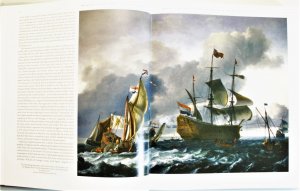
aftermath of the dutch raid on the Medway 1667 with flagship HMS Royal Charles beeing taken back to the Netherlands by a price crew
About the Author:
J D Davies was educated at Llanelli Grammar School and Jesus College, Oxford, where he completed a doctorate in 17th century naval history. He taught History for thirty years, chiefly at Bedford Modern School, where he also served as a Deputy Headmaster. He won the Samuel Pepys prize in 2009 for his book, 'Pepys's Navy: Ships, Men and Warfare 1649-89', was shortlisted for the Mountbatten Maritime Literary Award in 2014 for 'Britannia's Dragon: A Naval History of Wales', and is also a previous winner of the Julian Corbett prize for naval history. His acclaimed series of naval historical fiction, 'The Journals of Matthew Quinton' - described in 'The Times' as 'a series of real panache' - has been published in the UK, North America and Germany. David is a Fellow of the Royal Historical Society, chairman of committees of both the Society for Nautical Research and the Navy Records Society, and a former Chairman of the Naval Dockyards Society.
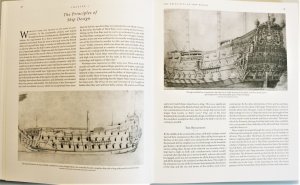
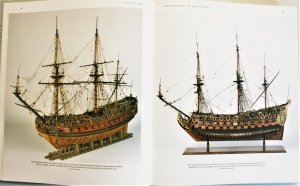
left side: HMS Royal Katherine 1664, Van de Velde English style three decker
right side: Third Rate HMS Grafton launched at Woolwich 1677, captured by french in 1797, Second Rate HMS Coronation 1685
Contents:
Part 1 – THE NAVY IN PEACE, WAR AND REVOLUTIONS (page 9 to 36)
The end of the third Royal Navy 1588-1649 – Republic, Restoration and the Wars with the Dutch – Naval Administration – The Navy, Naval Warfare and the British People
Part 2 – TYPES OF SHIPS (page 37 to 64)
The Principles of Ship Design – First to Third Rates – Fourth to Sixth Rates – Unrated Ships and Vessels
Part 3 – SHIPBUILDING (page 65 to 86)
Ship Construction – Fitting of Ships – Masts, Sails and Rigging – Armament
Part 4 – OFFICERS (Page 87 to 106)
Sea-Officers; Commissioned Officers – The Commissioned Officers; Gentlemen and Tarpaulins – Warrant Officers – Pay, Prize Money and Good Voyages
Part 5 – THE METHODS OF, AND OBSTACLES TO, NAVAL RECRUITMENT (Page 107 to 120)
The Problem of Naval Recruitment – Other Methods of Naval Recruitment – Merchant Service – Privateers
Part 6 – NAVAL CREWS (page 121 to 133)
Seamen´s Conditions of Service – Seamen, Petty Officers and Others – Soldiers, Marines and Volunteers – Prisoners of War
Part 7 – THE WORK OF THE SHIP (page 134 to 150)
Organisation and the Ship´s Day – Seamanship – Gunnery and Fighting – Navigation
Part 8 – SHIPBOARD LIFE (page 151 to 176)
The Necessities of Life – Rewards and Pleasures – Discipline – Mutiny and Desertion – Medicine and Health – Disasters – Religion
Part 9 – DOCKYARDS, BASES AND VICTUALLING (page 177 to 202)
The Work and Facilities of the Dockyards – Dockyard Officers and Workforce – ages and Naval Bases – Overseas Facilities – The VictuallingOrganisation
ages and Naval Bases – Overseas Facilities – The VictuallingOrganisation
Part 10 – FOREIGN NAVIES (page 203 to 221)
The Ducth Navy – The French Navy – The Barbary Corsairs – Other Foreign Naval Forces
Part 11 – STRATEGY AND DEPLOYMENT (page 222 to 246)
Strategy in the Anglo-Dutch Wars – The Main Fleet – The Mediterranean and Global Operations – Convoys, Cruisers, and Station Ships
Part 12 TACTICS AND BATTLE (page 247 to 268)
Fighting Tactics: The Evolution and Development of the Line of Battle – The Battle of Scheveningen – The Battle of Lowestoft – The Battle of Texel
Part 13 – AFTERMATH (page 269 to 284)
The Glorious Revolution and the Beginning of the French War – The Nine Years War and Beyond – Legacies
List of Abbreviations, Notes, Appendix, Further reading, Index
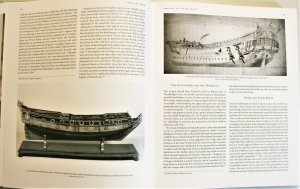
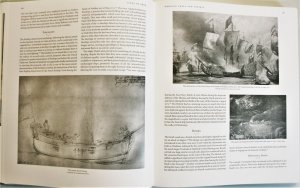
left side: Fourth Rate Frigate HMS Adventure 1646, drawing of Charles Galley by William Van De Velde the Younger
right side: The Smack Royal Escape, Destruction of the HMS Royal James at Battle of Solebay 1672, attack of Dieppe by bomb vessels 1694
The book received the Pepys Prize and Latham Medal, 2009
JD Davies’s authoritative study of the fledgling Royal Navy – PEPYS’S NAVY: Ships, Men and Warfare 1649-1689 – has won the fourth Samuel Pepys Award.
In PEPYS’S NAVY (Seaforth Publishing), David Davies examines every aspect of the English navy in the second half of the seventeenth century, from the time when the Fleet was taken into Parliamentary control after the defeat of Charles I, until the accession of William and Mary in 1689 when the long period of struggle with the Dutch came to an end. This crucial era witnessed the creation of a permanent naval service, in essence the birth of the Royal Navy.
Samuel Pepys played a pivotal role in the creation of a professional navy, first as a member of the Navy Board and later as Secretary to the Admiralty. His thirty years’ service did much to replace the ad hoc processes of the past with systems for construction and administration. That, by 1690, the navy was ready for a century of struggle against the French owed much to Pepys’s tireless work.
The judges, who included the inaugural winner of the Award, Claire Tomalin, were unanimous in their decision to award the prize to David Davies. Speaking on behalf of the judges, Ann Sweeney (Chairman), commented,
“We expect PEPYS’S NAVY to become an enduring work of reference. Very comprehensive and written with great authority, David Davies has shown his total knowledge of secondary sources balanced by his own research. The excellent descriptions of sea battles and the minutiae of ship-board life are supported by superb illustrations. This is an exceptional successor to his previous book Gentlemen and Tarpaulins. It is a book we would all like to have on our bookshelves.”
The Samuel Pepys Award is a biennial prize and is given for a book that, in the opinion of the judges, makes the greatest contribution to the understanding of Samuel Pepys, his times or his contemporaries in the interest of encouraging scholarship in this area. The first award was given to Claire Tomalin’s Samuel Pepys: The Unequalled Self in 2003 to mark the tercentenary of his death in May 1703. Frances Harris won the award in 2005 for Transformations of Love, for her vivid portrait of John Evelyn’s ‘chaste but passionate’ friendship with Margaret Godolphin, a maid of honour at the Restoration court of Charles II. In 2007, the Award was made to John Adamson for The Noble Revolt, an absorbing narrative of the period between the king’s decision to fight the Scots in May 1640 and his flight from London in January 1642.
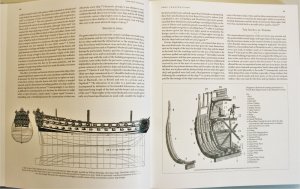
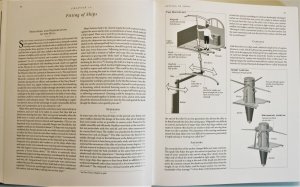
left side: drawing by William Keltridge of a large Third Rate HMS Royal Oak 1674, framing and beams of Fourth Rate Frigate HMS Hampshire 1653
right side: The Whipstaff and Crab Capstan
Review:
Apart from Frank Fox's "Great Ships - The Battlefleet of King Charles 2nd" (review also here on SOS), a now very hard to get hold of book, there are not many books detailing the life and doctrines of the Restoration period. The book is covering all aspects of Navy life, in much the same way as the book "Nelson's Navy - its ships men and organisation" did for the Nelson period. It is well written, and easy to follow with the different aspects in their own chapters and sub chapters.
The book is sumptuously illustrated throughout its 304 pages with paintings, contemporary drawings and photographs of Navy Board models.
If you are interested in this period, this book certainly will not disappoint, it is very good value for money too.
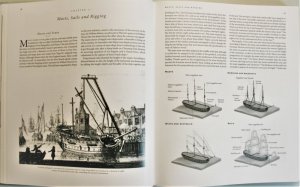
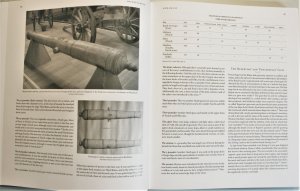
left side: lifting of main mast by derrick 1706, parts of masts and rigging, sails
right side: bronze demi-culverin of Sovereign of the Seas, demi-cannon Barbados
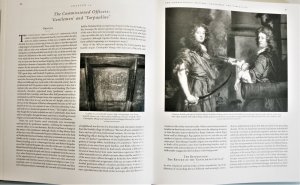
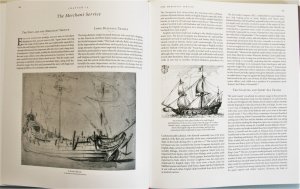
right side: the dutch Flyboat, small english merchantman Annales 1654
More Look Inside photos you can find in the following post .....
Pepys's Navy: Ships, Men and Warfare 1649-89
by J.D. Davies


avialable as
Hardcover: 320 pages
Publisher: Seaforth Publishing; 1st Edition edition (20 Nov. 2008),
Language: English
Product Dimensions: 25.4 x 2.5 x 29.8 cm
or

Paperback: 320 pages
Publisher: Seaforth Publishing (30 July 2016)
Product Dimensions: 26.3 x 2.4 x 22.6 cm
Synopsis:
This new reference book describes every aspect the English navy in the second half of the seventeenth century, from the time when the Fleet Royal was taken into Parliamentary control after the defeat of Charles I, until the accession of William and Mary in 1689 when the long period of war with the Dutch came to an end. This is a crucial era which witnessed the creation of a permanent naval service, in essence the birth of the Royal Navy.Every aspect of the navy is covered - naval administration, ship types and shipbuilding, naval recruitment and crews, seamanship and gunnery, shipboard life, dockyards and bases, the foreign navies of the period, and the three major wars which were fought against the Dutch in the Channel and the North Sea. Samuel Pepys, whose thirty years of service did so much to replace the ad hoc processes of the past with systems for construction and administration, is one of the most significant players, and the navy which was, by 1690, ready for the 100 years of global struggle with the French owed much to his tireless work.This book is destined to become a major work for historians, naval enthusiasts and, indeed, anyone with an interest in this colourful era of the seventeenth century. JD Davies's authoritative study of the fledgling Royal Navy - PEPYS'S NAVY: Ships, Men and Warfare 1649-1689 - has won the fourth Samuel Pepys Award. In PEPYS'S NAVY, David Davies examines every aspect of the English navy in the second half of the seventeenth century, from the time when the Fleet was taken into Parliamentary control after the defeat of Charles I, until the accession of William and Mary in 1689 when the long period of struggle with the Dutch came to an end. This crucial era witnessed the creation of a permanent naval service, in essence the birth of the Royal Navy.Samuel Pepys played a pivotal role in the creation of a professional navy, first as a member of the Navy Board and later as Secretary to the Admiralty. His thirty years' service did much to replace the ad hoc processes of the past with systems for construction and administration. That, by 1690, the navy was ready for a century of struggle against the French owed much to Pepys's tireless work.The judges, who included the inaugural winner of the Award, Claire Tomalin, were unanimous in their decision to award the prize to David Davies.Speaking on behalf of the judges, Ann Sweeney (Chairman), commented, We expect PEPYS'S NAVY to become an enduring work of reference. Very comprehensive and written with great authority.

aftermath of the dutch raid on the Medway 1667 with flagship HMS Royal Charles beeing taken back to the Netherlands by a price crew
About the Author:
J D Davies was educated at Llanelli Grammar School and Jesus College, Oxford, where he completed a doctorate in 17th century naval history. He taught History for thirty years, chiefly at Bedford Modern School, where he also served as a Deputy Headmaster. He won the Samuel Pepys prize in 2009 for his book, 'Pepys's Navy: Ships, Men and Warfare 1649-89', was shortlisted for the Mountbatten Maritime Literary Award in 2014 for 'Britannia's Dragon: A Naval History of Wales', and is also a previous winner of the Julian Corbett prize for naval history. His acclaimed series of naval historical fiction, 'The Journals of Matthew Quinton' - described in 'The Times' as 'a series of real panache' - has been published in the UK, North America and Germany. David is a Fellow of the Royal Historical Society, chairman of committees of both the Society for Nautical Research and the Navy Records Society, and a former Chairman of the Naval Dockyards Society.


left side: HMS Royal Katherine 1664, Van de Velde English style three decker
right side: Third Rate HMS Grafton launched at Woolwich 1677, captured by french in 1797, Second Rate HMS Coronation 1685
Contents:
Part 1 – THE NAVY IN PEACE, WAR AND REVOLUTIONS (page 9 to 36)
The end of the third Royal Navy 1588-1649 – Republic, Restoration and the Wars with the Dutch – Naval Administration – The Navy, Naval Warfare and the British People
Part 2 – TYPES OF SHIPS (page 37 to 64)
The Principles of Ship Design – First to Third Rates – Fourth to Sixth Rates – Unrated Ships and Vessels
Part 3 – SHIPBUILDING (page 65 to 86)
Ship Construction – Fitting of Ships – Masts, Sails and Rigging – Armament
Part 4 – OFFICERS (Page 87 to 106)
Sea-Officers; Commissioned Officers – The Commissioned Officers; Gentlemen and Tarpaulins – Warrant Officers – Pay, Prize Money and Good Voyages
Part 5 – THE METHODS OF, AND OBSTACLES TO, NAVAL RECRUITMENT (Page 107 to 120)
The Problem of Naval Recruitment – Other Methods of Naval Recruitment – Merchant Service – Privateers
Part 6 – NAVAL CREWS (page 121 to 133)
Seamen´s Conditions of Service – Seamen, Petty Officers and Others – Soldiers, Marines and Volunteers – Prisoners of War
Part 7 – THE WORK OF THE SHIP (page 134 to 150)
Organisation and the Ship´s Day – Seamanship – Gunnery and Fighting – Navigation
Part 8 – SHIPBOARD LIFE (page 151 to 176)
The Necessities of Life – Rewards and Pleasures – Discipline – Mutiny and Desertion – Medicine and Health – Disasters – Religion
Part 9 – DOCKYARDS, BASES AND VICTUALLING (page 177 to 202)
The Work and Facilities of the Dockyards – Dockyard Officers and Workforce –
 ages and Naval Bases – Overseas Facilities – The VictuallingOrganisation
ages and Naval Bases – Overseas Facilities – The VictuallingOrganisationPart 10 – FOREIGN NAVIES (page 203 to 221)
The Ducth Navy – The French Navy – The Barbary Corsairs – Other Foreign Naval Forces
Part 11 – STRATEGY AND DEPLOYMENT (page 222 to 246)
Strategy in the Anglo-Dutch Wars – The Main Fleet – The Mediterranean and Global Operations – Convoys, Cruisers, and Station Ships
Part 12 TACTICS AND BATTLE (page 247 to 268)
Fighting Tactics: The Evolution and Development of the Line of Battle – The Battle of Scheveningen – The Battle of Lowestoft – The Battle of Texel
Part 13 – AFTERMATH (page 269 to 284)
The Glorious Revolution and the Beginning of the French War – The Nine Years War and Beyond – Legacies
List of Abbreviations, Notes, Appendix, Further reading, Index


left side: Fourth Rate Frigate HMS Adventure 1646, drawing of Charles Galley by William Van De Velde the Younger
right side: The Smack Royal Escape, Destruction of the HMS Royal James at Battle of Solebay 1672, attack of Dieppe by bomb vessels 1694
The book received the Pepys Prize and Latham Medal, 2009
JD Davies’s authoritative study of the fledgling Royal Navy – PEPYS’S NAVY: Ships, Men and Warfare 1649-1689 – has won the fourth Samuel Pepys Award.
In PEPYS’S NAVY (Seaforth Publishing), David Davies examines every aspect of the English navy in the second half of the seventeenth century, from the time when the Fleet was taken into Parliamentary control after the defeat of Charles I, until the accession of William and Mary in 1689 when the long period of struggle with the Dutch came to an end. This crucial era witnessed the creation of a permanent naval service, in essence the birth of the Royal Navy.
Samuel Pepys played a pivotal role in the creation of a professional navy, first as a member of the Navy Board and later as Secretary to the Admiralty. His thirty years’ service did much to replace the ad hoc processes of the past with systems for construction and administration. That, by 1690, the navy was ready for a century of struggle against the French owed much to Pepys’s tireless work.
The judges, who included the inaugural winner of the Award, Claire Tomalin, were unanimous in their decision to award the prize to David Davies. Speaking on behalf of the judges, Ann Sweeney (Chairman), commented,
“We expect PEPYS’S NAVY to become an enduring work of reference. Very comprehensive and written with great authority, David Davies has shown his total knowledge of secondary sources balanced by his own research. The excellent descriptions of sea battles and the minutiae of ship-board life are supported by superb illustrations. This is an exceptional successor to his previous book Gentlemen and Tarpaulins. It is a book we would all like to have on our bookshelves.”
The Samuel Pepys Award is a biennial prize and is given for a book that, in the opinion of the judges, makes the greatest contribution to the understanding of Samuel Pepys, his times or his contemporaries in the interest of encouraging scholarship in this area. The first award was given to Claire Tomalin’s Samuel Pepys: The Unequalled Self in 2003 to mark the tercentenary of his death in May 1703. Frances Harris won the award in 2005 for Transformations of Love, for her vivid portrait of John Evelyn’s ‘chaste but passionate’ friendship with Margaret Godolphin, a maid of honour at the Restoration court of Charles II. In 2007, the Award was made to John Adamson for The Noble Revolt, an absorbing narrative of the period between the king’s decision to fight the Scots in May 1640 and his flight from London in January 1642.


left side: drawing by William Keltridge of a large Third Rate HMS Royal Oak 1674, framing and beams of Fourth Rate Frigate HMS Hampshire 1653
right side: The Whipstaff and Crab Capstan
Review:
Apart from Frank Fox's "Great Ships - The Battlefleet of King Charles 2nd" (review also here on SOS), a now very hard to get hold of book, there are not many books detailing the life and doctrines of the Restoration period. The book is covering all aspects of Navy life, in much the same way as the book "Nelson's Navy - its ships men and organisation" did for the Nelson period. It is well written, and easy to follow with the different aspects in their own chapters and sub chapters.
The book is sumptuously illustrated throughout its 304 pages with paintings, contemporary drawings and photographs of Navy Board models.
If you are interested in this period, this book certainly will not disappoint, it is very good value for money too.


left side: lifting of main mast by derrick 1706, parts of masts and rigging, sails
right side: bronze demi-culverin of Sovereign of the Seas, demi-cannon Barbados


right side: the dutch Flyboat, small english merchantman Annales 1654
More Look Inside photos you can find in the following post .....




